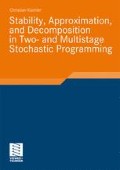Zusammenfassung
As we have discussed in the previous chapters, many stochastic optimization problems do not allow for an analytic solution, and, hence, one has to resort to numerical approaches. However, numerical approaches usually require the underlying probability measures to have only a finite support. While such finite measures can be obtained, e.g., by sampling or from historical data, the number of atoms (or, scenarios) has to be in general sufficiently small to maintain the numerical tractability. Approximating a (finite) probability measure by a measure with a smaller number of atoms is denoted as scenario reduction in the literature.
Access this chapter
Tax calculation will be finalised at checkout
Purchases are for personal use only
Preview
Unable to display preview. Download preview PDF.
Rights and permissions
Copyright information
© 2009 Vieweg+Teubner | GWV Fachverlage GmbH
About this chapter
Cite this chapter
Küchler, C. (2009). Scenario Reduction with Respect to Discrepancy Distances. In: Stability, Approximation, and Decomposition in Two- and Multistage Stochastic Programming. Vieweg+Teubner. https://doi.org/10.1007/978-3-8348-9399-4_4
Download citation
DOI: https://doi.org/10.1007/978-3-8348-9399-4_4
Publisher Name: Vieweg+Teubner
Print ISBN: 978-3-8348-0921-6
Online ISBN: 978-3-8348-9399-4
eBook Packages: Mathematics and StatisticsMathematics and Statistics (R0)

